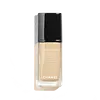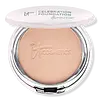Chanel Vitalumière Radiant Moisture-Rich Fluid Foundation Versus IT Cosmetics Celebration Foundation Illumination
What's inside
What's inside
 Key Ingredients
Key Ingredients

 Benefits
Benefits

 Concerns
Concerns

 Ingredients Side-by-side
Ingredients Side-by-side

Water
Skin ConditioningCaprylic/Capric Triglyceride
MaskingGlycerin
HumectantEthylhexyl Palmitate
EmollientRicinus Communis Seed Oil
MaskingUndecane
EmollientPolyglyceryl-3 PCA
EmollientPolyglyceryl-6 Polyhydroxystearate
EmulsifyingSynthetic Fluorphlogopite
Propylene Glycol
HumectantSilica
AbrasivePolyglyceryl-6 Polyricinoleate
EmulsifyingTridecane
PerfumingMagnesium Sulfate
Sodium Chloride
MaskingTerminalia Ferdinandiana Fruit Extract
AntioxidantGlycyrrhiza Glabra Root Extract
BleachingButylene Glycol
HumectantStearalkonium Hectorite
Gel FormingTocopheryl Acetate
AntioxidantParfum
MaskingPotassium Sorbate
PreservativeDisodium Stearoyl Glutamate
CleansingCaprylyl Glycol
EmollientPropylene Carbonate
SolventPentylene Glycol
Skin ConditioningLauroyl Lysine
Skin ConditioningSodium Hyaluronate
HumectantAluminum Hydroxide
EmollientLaminaria Digitata Extract
Skin ProtectingTocopherol
AntioxidantAscorbyl Palmitate
AntioxidantHelianthus Annuus Seed Oil
EmollientCI 77007
Cosmetic ColorantCI 77491
Cosmetic ColorantCI 77492
Cosmetic ColorantCI 77499
Cosmetic ColorantCI 77891
Cosmetic ColorantMica
Cosmetic ColorantWater, Caprylic/Capric Triglyceride, Glycerin, Ethylhexyl Palmitate, Ricinus Communis Seed Oil, Undecane, Polyglyceryl-3 PCA, Polyglyceryl-6 Polyhydroxystearate, Synthetic Fluorphlogopite, Propylene Glycol, Silica, Polyglyceryl-6 Polyricinoleate, Tridecane, Magnesium Sulfate, Sodium Chloride, Terminalia Ferdinandiana Fruit Extract, Glycyrrhiza Glabra Root Extract, Butylene Glycol, Stearalkonium Hectorite, Tocopheryl Acetate, Parfum, Potassium Sorbate, Disodium Stearoyl Glutamate, Caprylyl Glycol, Propylene Carbonate, Pentylene Glycol, Lauroyl Lysine, Sodium Hyaluronate, Aluminum Hydroxide, Laminaria Digitata Extract, Tocopherol, Ascorbyl Palmitate, Helianthus Annuus Seed Oil, CI 77007, CI 77491, CI 77492, CI 77499, CI 77891, Mica
Lauroyl Lysine
Skin ConditioningEthylhexyl Palmitate
EmollientZinc Stearate
Cosmetic ColorantCaprylyl Glycol
EmollientEthylhexylglycerin
Skin ConditioningSerica Powder
Skin ConditioningWater
Skin ConditioningTocopherol
AntioxidantGlycerin
HumectantSodium Hyaluronate
HumectantAscorbyl Palmitate
AntioxidantIsopropyl Palmitate
EmollientIsopropyl Myristate
EmollientButylene Glycol
HumectantHydrolyzed Collagen
EmollientOlea Europaea Fruit Extract
BleachingAloe Barbadensis Leaf Extract
EmollientCarbomer
Emulsion StabilisingSodium Lactate
BufferingCarica Papaya Fruit Extract
Skin ConditioningPolysorbate 20
EmulsifyingSodium Benzoate
MaskingPotassium Sorbate
PreservativePalmitoyl Tripeptide-1
Skin ConditioningPalmitoyl Tetrapeptide-7
Skin ConditioningMica
Cosmetic ColorantCI 77891
Cosmetic ColorantCI 77491
Cosmetic ColorantCI 77492
Cosmetic ColorantCI 77499
Cosmetic ColorantLauroyl Lysine, Ethylhexyl Palmitate, Zinc Stearate, Caprylyl Glycol, Ethylhexylglycerin, Serica Powder, Water, Tocopherol, Glycerin, Sodium Hyaluronate, Ascorbyl Palmitate, Isopropyl Palmitate, Isopropyl Myristate, Butylene Glycol, Hydrolyzed Collagen, Olea Europaea Fruit Extract, Aloe Barbadensis Leaf Extract, Carbomer, Sodium Lactate, Carica Papaya Fruit Extract, Polysorbate 20, Sodium Benzoate, Potassium Sorbate, Palmitoyl Tripeptide-1, Palmitoyl Tetrapeptide-7, Mica, CI 77891, CI 77491, CI 77492, CI 77499
Ingredients Explained
These ingredients are found in both products.
Ingredients higher up in an ingredient list are typically present in a larger amount.
Ascorbyl Palmitate is created by combining pure Vitamin C and palmitic acid. It is an antioxidant and helps reduce hyperpigmentation.
This ingredient is a more stable version of Vitamin C, meaning it does not disintegrate as quickly when exposed to sunlight. However, studies show it does not penetrate skin as well as pure Vitamin C.
Ascorbyl Palmitate is oil soluble.
Read more about other types of Vitamin C:
Learn more about Ascorbyl PalmitateButylene Glycol (or BG) is used within cosmetic products for a few different reasons:
Overall, Butylene Glycol is a safe and well-rounded ingredient that works well with other ingredients.
Though this ingredient works well with most skin types, some people with sensitive skin may experience a reaction such as allergic rashes, closed comedones, or itchiness.
Learn more about Butylene GlycolCaprylyl Glycol is a humectant and emollient, meaning it attracts and preserves moisture.
It is a common ingredient in many products, especially those designed to hydrate skin. The primary benefits are retaining moisture, skin softening, and promoting a healthy skin barrier.
Though Caprylyl Glycol is an alcohol derived from fatty acids, it is not the kind that can dry out skin.
This ingredient is also used as a preservative to extend the life of products. It has slight antimicrobial properties.
Learn more about Caprylyl GlycolCi 77491 is also hydrated iron III oxide. It's sole purpose is to give a red/pink hue to products.
Iron III oxides are classified as inorganic chemicals for coloring.
Synthetically created Ci 77491 is considered safer than those naturally found. This is because the synthetically created version may contain less impurities. Iron oxides are generally non-toxic and non-allergenic.
Learn more about CI 77491Ci 77492 is also hydrated iron III oxide. It's sole purpose is to give a yellow hue to products.
Iron III oxides are classified as inorganic chemicals for coloring.
Synthetically created Ci 77492 is considered safer than those naturally found. This is because the synthetically created version may contain less impurities. Iron oxides are generally non-toxic and non-allergenic.
Learn more about CI 77492Ci 77499 is also hydrated iron III oxide. It is created from mixing red and black iron oxides. This helps give shades of darkness to a product.
Iron III oxides are classified as inorganic chemicals for coloring.
Ci 77891 is a white pigment from Titanium dioxide. It is naturally found in minerals such as rutile and ilmenite.
It's main function is to add a white color to cosmetics. It can also be mixed with other colors to create different shades.
Ci 77891 is commonly found in sunscreens due to its ability to block UV rays.
Learn more about CI 77891Ethylhexyl Palmitate, also known as octyl palmitate, is created from 2-ethylhexyl alcohol and palmitic acid. It is a fatty acid ester.
The fatty acid content of Ethylhexyl Palmitate makes it an emollient. Emollients help soften and hydrate your skin by trapping moisture within.
Ethylhexyl Palmitate is also used to help improve the texture of cosmetics. It helps other ingredient dissolve in products and help disperse ingredients more evenly.
You'll likely find this ingredient in sunscreen, as it is often used to mix UV-blocking ingredients such as avobenzone and ethylhexyl triazone.
It can also help stabilize the fragrances in a product as a fragrance fixative.
Ethylhexyl Palmitate can be used to substitute mineral oil.
Due to its high fatty acid content, it may not be fungal-acne safe.
Learn more about Ethylhexyl PalmitateGlycerin is already naturally found in your skin. It helps moisturize and protect your skin.
A study from 2016 found glycerin to be more effective as a humectant than AHAs and hyaluronic acid.
As a humectant, it helps the skin stay hydrated by pulling moisture to your skin. The low molecular weight of glycerin allows it to pull moisture into the deeper layers of your skin.
Hydrated skin improves your skin barrier; Your skin barrier helps protect against irritants and bacteria.
Glycerin has also been found to have antimicrobial and antiviral properties. Due to these properties, glycerin is often used in wound and burn treatments.
In cosmetics, glycerin is usually derived from plants such as soybean or palm. However, it can also be sourced from animals, such as tallow or animal fat.
This ingredient is organic, colorless, odorless, and non-toxic.
Glycerin is the name for this ingredient in American English. British English uses Glycerol/Glycerine.
Learn more about GlycerinThis ingredient comes from a fatty acid (lauric acid) and amino acid (lysine). It is used to add a silky feel to cosmetics.
According to a manufacturer, its fatty acid base leaves a silky feeling on the skin. It also has emollient properties because of this. Emollients help soften skin by preventing water from evaporating.
Lauroyl lysine is barely soluble in water.
Learn more about Lauroyl LysineMica is a naturally occurring mineral used to add shimmer and color in cosmetics. It can also help improve the texture of a product or give it an opaque, white/silver color.
Serecite is the name for very fine but ragged grains of mica.
This ingredient is often coated with metal oxides like titanium dioxide. Trace amounts of heavy metals may be found in mica, but these metals are not harmful in our personal products.
Mica has been used since prehistoric times throughout the world. Ancient Egyptian, Indian, Greek, Roman, Aztec, and Chinese civilizations have used mica.
Learn more about MicaPotassium Sorbate is a preservative used to prevent yeast and mold in products. It is commonly found in both cosmetic and food products.
This ingredient comes from potassium salt derived from sorbic acid. Sorbic acid is a natural antibiotic and effective against fungus.
Both potassium sorbate and sorbic acid can be found in baked goods, cheeses, dried meats, dried fruit, ice cream, pickles, wine, yogurt, and more.
You'll often find this ingredient used with other preservatives.
Learn more about Potassium SorbateSodium Hyaluronate is hyaluronic acid's salt form. It is commonly derived from the sodium salt of hyaluronic acid.
Like hyaluronic acid, it is great at holding water and acts as a humectant. This makes it a great skin hydrating ingredient.
Sodium Hyaluronate is naturally occurring in our bodies and is mostly found in eye fluid and joints.
These are some other common types of Hyaluronic Acid:
Learn more about Sodium HyaluronateTocopherol (also known as Vitamin E) is a common antioxidant used to help protect the skin from free-radicals and strengthen the skin barrier. It's also fat soluble - this means our skin is great at absorbing it.
Vitamin E also helps keep your natural skin lipids healthy. Your lipid skin barrier naturally consists of lipids, ceramides, and fatty acids. Vitamin E offers extra protection for your skin’s lipid barrier, keeping your skin healthy and nourished.
Another benefit is a bit of UV protection. Vitamin E helps reduce the damage caused by UVB rays. (It should not replace your sunscreen). Combining it with Vitamin C can decrease sunburned cells and hyperpigmentation after UV exposure.
You might have noticed Vitamin E + C often paired together. This is because it is great at stabilizing Vitamin C. Using the two together helps increase the effectiveness of both ingredients.
There are often claims that Vitamin E can reduce/prevent scarring, but these claims haven't been confirmed by scientific research.
Learn more about TocopherolWater. It's the most common cosmetic ingredient of all. You'll usually see it at the top of ingredient lists, meaning that it makes up the largest part of the product.
So why is it so popular? Water most often acts as a solvent - this means that it helps dissolve other ingredients into the formulation.
You'll also recognize water as that liquid we all need to stay alive. If you see this, drink a glass of water. Stay hydrated!
Learn more about Water